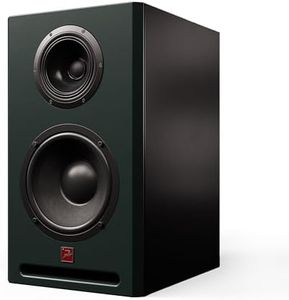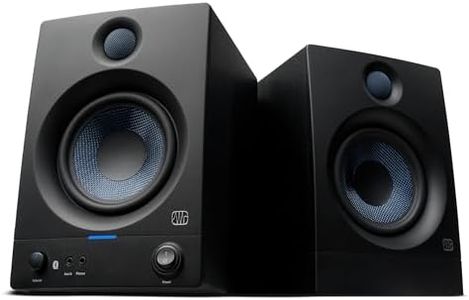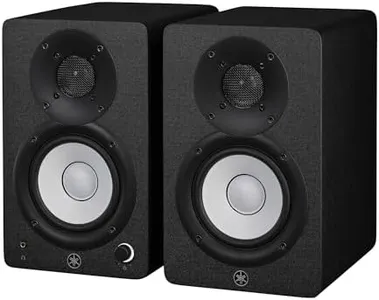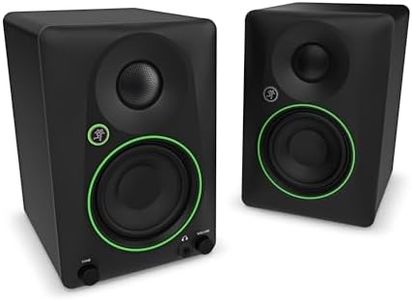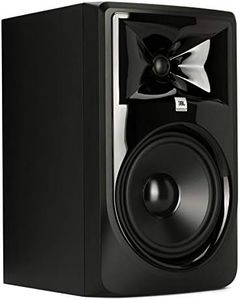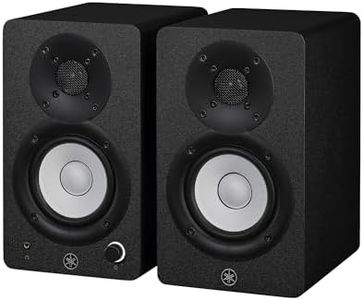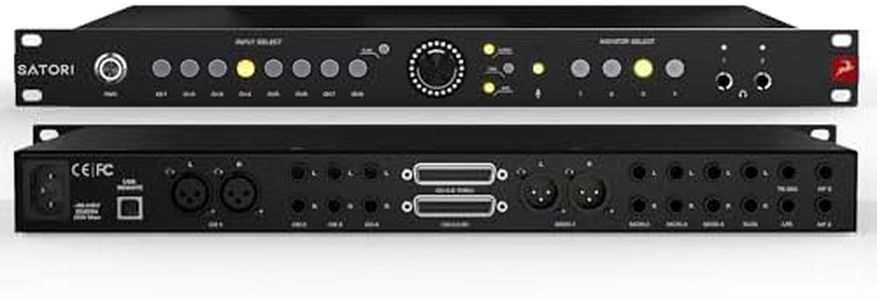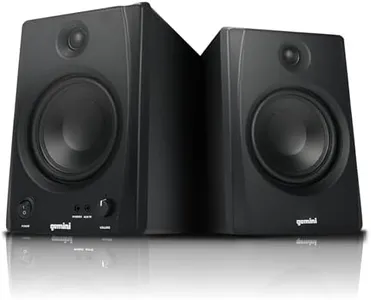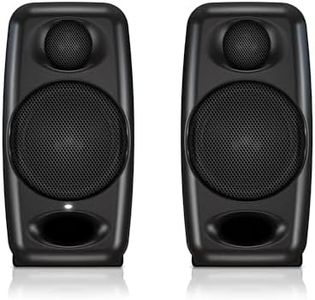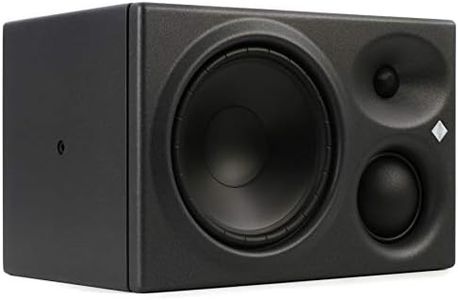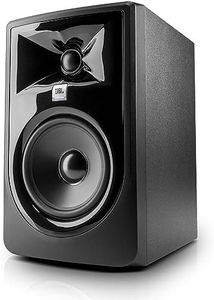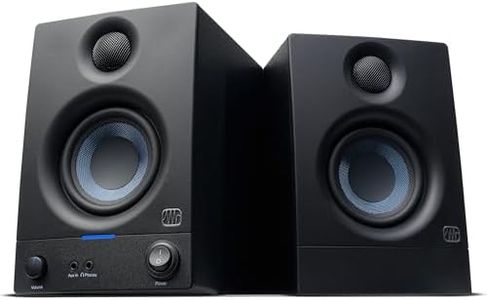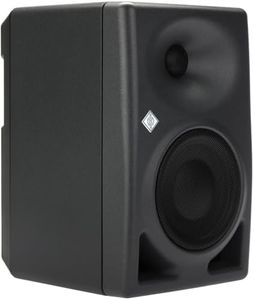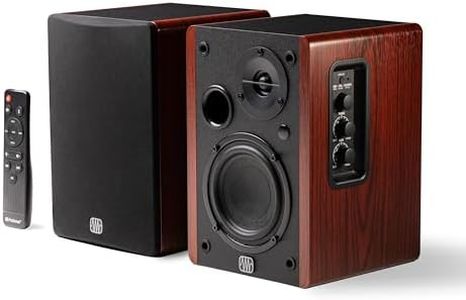10 Best Studio Speakers 2025 in the United States
Our technology thoroughly searches through the online shopping world, reviewing hundreds of sites. We then process and analyze this information, updating in real-time to bring you the latest top-rated products. This way, you always get the best and most current options available.

Our Top Picks
Winner
PreSonus Eris 5BT Bluetooth Studio Monitors, Pair — 5.25" Inch Powered Bookshelf Speakers, Stereo, Desktop Computer, Near Field Music Production, Audio Mixing Recording
Most important from
23270 reviews
The PreSonus Eris 5BT studio monitors are powered bookshelf speakers designed for home studios, desktop setups, and near-field music production. Their 5.25-inch woofers and 1-inch silk-dome tweeters deliver clear, balanced sound with good low-end punch, important for mixing and audio clarity. With 100 watts of Class AB amplification (50 watts per speaker), these monitors achieve solid volume levels without distortion, suitable for small to medium-sized rooms.
Bluetooth 5.0 provides convenient wireless connectivity to smartphones or tablets, while multiple wired inputs (balanced 1/4" TRS and RCA) ensure compatibility with professional and consumer audio gear. This flexibility benefits users who switch between different devices or setups. The Eris 5BTs also include a front-panel headphone output and controls to adjust high and low frequencies, helping tailor sound to room acoustics, especially in less ideal spaces. Their compact size suits desktop use or small rooms, with the option to add the Eris Sub 8BT subwoofer for enhanced low-end power.
These monitors are active (powered), requiring no external amplifier, simplifying setup. Given their price and features, they represent a strong choice for beginner to intermediate home studio users or anyone needing clear, accurate monitoring on a desktop or in small rooms. While they may not meet the needs of professionals seeking extremely flat response or larger room coverage, their sound quality and connectivity options are impressive for their size and price.
Most important from
23270 reviews
Yamaha HS4 Powered Studio Monitor in Black, Pair (HS4 B)
Most important from
1716 reviews
The Yamaha HS4 Powered Studio Monitors are a solid choice for those looking for reliable audio quality in a compact setup. With a frequency response of 60 Hz - 22 kHz, these speakers offer a broad range, though they may not handle the lowest bass frequencies as effectively as larger monitors. The 4.5-inch cone woofer and 1-inch dome tweeter ensure a balanced sound output. Each speaker has an output power of 26 watts, providing sufficient volume for small to medium-sized rooms, making them ideal for home studios or smaller professional setups.
The inclusion of room control and high trim response controls allows for some customization to match your room's acoustics, which is a nice touch for fine-tuning sound quality. Connectivity via USB is straightforward, and the active (powered) design means you won't need an external amplifier. However, the USB connectivity might be limiting for those who prefer more traditional audio inputs like XLR or TRS jacks.
Weighing in at just under 15 pounds for the pair, they're relatively lightweight and portable. Keep in mind that while the Yamaha HS4 monitors are well-regarded, their smaller woofer size might not produce the deep lows some users might require for certain types of music production. These speakers are well-suited for beginners or intermediate users who need reliable, clear sound without the bulk of larger monitors.
Most important from
1716 reviews
Mackie CR8BT 8" Creative Reference Powered Studio Monitors with Bluetooth, Tone Knob and Location Switch — Active Speakers for Music Production, Desktop Computer, Gaming, HiFi Listening
Most important from
385 reviews
The Mackie CR8BT 8-inch Powered Bluetooth Studio Monitors stand out in the studio speaker category due to their robust features and versatile connectivity options. With an 8-inch dynamic woofer and 1-inch tweeter, these speakers deliver a clear and balanced sound which is ideal for studio recording and casual listening alike. The maximum output power of 140 watts ensures that they can fill a room with rich audio, making them suitable for both small studios and larger spaces.
One notable strength is their Bluetooth connectivity, allowing for easy pairing with smartphones, tablets, and computers, which adds convenience for casual listening or when working on projects. They're also equipped with a headphone output, providing a private listening option, which can be a significant advantage during detailed work sessions.
The Mackie CR8BT monitors excel in many areas, but there are a few aspects to consider. They are designed for indoor use and might not perform as well in varying room acoustics without proper sound treatment. Additionally, weighing in at 35.3 pounds, they are relatively heavy, which may make placement less convenient compared to lighter models. Furthermore, while the Bluetooth feature is great, some purists may prefer a wired connection for critical listening to avoid any potential latency.
Most important from
385 reviews
Buying Guide for the Best Studio Speakers
Choosing the right studio speakers is crucial for anyone involved in music production, sound engineering, or any audio-related work. The right speakers will provide accurate sound reproduction, allowing you to hear your work as it truly is. This guide will help you understand the key specifications to consider when selecting studio speakers and how to choose the best fit for your needs.FAQ
Most Popular Categories Right Now
